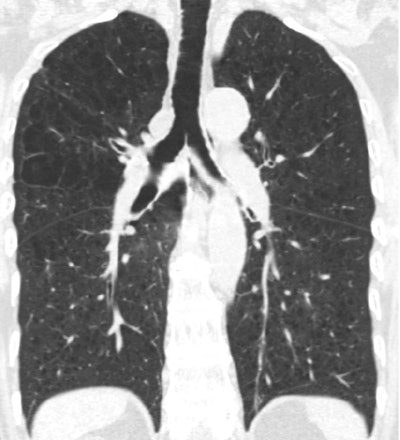
CT scans show that people with emphysema are at risk of earlier death than those without the disease, even if they have no evidence of chronic obstructive pulmonary disease (COPD) or airflow obstruction, according to a study published on Monday in the Annals of Internal Medicine.
The analysis was based on data from a Multiethnic Study of Atherosclerosis (MESA) cohort of almost 3,000 individuals. It showed that those with emphysema-like findings on CT faced a higher risk of death even after adjustment for multiple risk factors, which was somewhat of a surprise to the authors from Columbia University Medical Center (CUMC) in New York City.
"Over six years of follow-up, we found there was an association between emphysema-like lung [tissue] discovered on CT and all-cause mortality," Dr. Elizabeth Oelsner, an instructor in medicine at CUMC, explained in an interview with AuntMinnie.com. "It was independent of a lot of other risk factors, including smoking and pack-years of smoking."
The researchers found a statistically significant association between greater emphysema-like lung tissue and mortality, with an overall adjusted hazard ratio of 1.14 (p = 0.004). The relationship was calculated after adjusting for a wide range of potential confounders, from weight and age to cholesterol levels and cardiovascular risk factors, the study team reported (Ann Intern Med, December 15, 2014).
A leading cause of death
COPD, defined as airflow obstruction on spirometry, is the third leading cause of death in the U.S., Oelsner said.
Measures of airflow obstruction have been associated with mortality; however, emphysema is defined as air-space dilation due to parenchymal destruction. And while emphysema can be defined on histology, in practice it is CT attenuation that defines the disease (< -950 HU in this study).
"When people talk about COPD, they often lump emphysema along with it, even though emphysema is defined differently," Oelsner said. Confounding the two diseases meant that "we didn't know all that's going on. We didn't know what to expect for emphysema in the absence of COPD, so that's what we set out to study."
Previously, it's been shown that emphysema might be associated with a poor prognosis in heavy smokers, but researchers haven't examined people who don't have COPD but who may have some extent of emphysema, she continued.
 CT scan of lung showing emphysema. Image courtesy of Dr. Elizabeth Oelsner.
CT scan of lung showing emphysema. Image courtesy of Dr. Elizabeth Oelsner.MESA participants without airflow obstruction
The research team examined 2,985 MESA participants ages 45 to 84 years who did not have airflow obstruction on spirometry. They defined emphysema-like lung as the number of lung voxels with attenuation less than -950 HU on cardiac CT after adjusting for the number of total imaged lung voxels.
This being the MESA study, the CT exams were acquired more than 10 years ago with the technology of the time. Images were acquired on electron-beam or MDCT scanners from 2000 to 2002. Two scans were performed for each patient using a full breathhold from the carina to the lung base with transverse fields-of-view that captured the entire lung field, the authors wrote.
Spirometry was performed in accordance with the joint guidelines from the American Thoracic Society and European Respiratory Society, using a dry rolling-seal spirometer. The study defined airflow obstruction as a forced expiratory volume in one second (FEV1)/forced vital capacity (FVC) ratio less than 0.70, based on current guidelines; the absence of airflow obstruction excluded COPD.
Adjusted for confounders
After adjusting the number of emphysema-like voxels in the lung images for total imaged lung voxels, the analyses were sequentially adjusted for CT scanner type, tube current, and site, as well as baseline age, sex, race/ethnicity, weight, height, educational attainment, smoking status and number of pack-years, alcohol use, and Agatston score. The researchers also factored in diabetes medication use, fasting glucose levels, total and high-density lipoprotein cholesterol levels, creatinine levels, history of cancer, and FEV1 spirometry results, among other factors. All primary results were then stratified by smoking status.
Participants with more emphysema-like voxels were predominantly male, more likely to be white, had attained higher education levels, and were more likely to have smoked cigarettes.
"Emphysema-like lung assessed quantitatively on CT was associated with increased all-cause mortality among persons without airflow obstruction or COPD on spirometry in a large, population-based, multiethnic cohort," the study team wrote. "This association was independent of many potential confounders, including FEV1, and persisted among participants without physician-diagnosed emphysema or asthma."
Emphysema clinically relevant on its own
The findings were of greater magnitude among former and current smokers than among those who had never smoked, according to the authors.
"We did see a stronger association [between emphysema and mortality] among smokers than among never-smokers," Oelsner said. "There are many ways to interpret this finding, but what we decided, based on looking at all our data, is that we couldn't confirm or rule out an association between emphysema and mortality among the never-smokers. But there was a strong association demonstrated among smokers -- and this was after adjustment for very many reasons to have bad outcomes. So this association between emphysema and all-cause mortality was shown to be independent of a lot of other factors that might lead them to have bad outcomes."
Could the use of older CT scanning technology limit the validity of the results?
"We think that it was enough to find this result," she said.
The researchers were obviously limited by the use of the older technologies, Oelsner added, but they could not find any differences in the results when they were stratified by scanner type: electron-beam CT or MDCT.
The results suggest that subclinical emphysema in patients without spirometrically defined COPD is clinically relevant, the authors wrote.
"I think the exciting thing about our finding is we have shown that emphysema has an impact on prognosis independent of COPD; that even if you have normal airflow on a breathing test, a finding of emphysema might be meaningful," Oelsner said.
The finding is particularly important as healthcare enters an age in which more people will have chest CT scans that might identify emphysema incidentally, she said. Even if breathing tests don't show COPD, healthcare providers might want to talk to them about the health risks of emphysema.
Going forward, it's clear that more knowledge is needed about emphysema findings in never-smokers, where the relationship between emphysema and mortality was not definitively established, she said.
It's also time to think about whether treatments can be developed that target emphysema in the absence of COPD, "because at this time, there are none," Oelsner said.




















